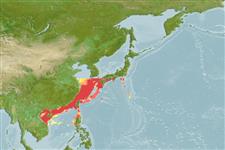Environment: milieu / climate zone / depth range / distribution range
Ecologia
marinhas demersal; oceanódromo (Ref. 51243); intervalo de profundidade 10 - 200 m (Ref. 41299). Subtropical; 34°N - 15°N
Northwest Pacific: northeastern part of South China Sea (Philippines excluded) northward to Japan.
Length at first maturity / Tamanho / Peso / Idade
Maturity: Lm 34.3 range ? - ? cm
Max length : 100.0 cm SL macho/indeterminado; (Ref. 559); common length : 30.0 cm TL macho/indeterminado; (Ref. 2115); peso máx. Publicado: 9.7 kg (Ref. 40637); Idade máx. registada: 26 anos (Ref. 56606)
Descrição breve
Chaves de identificação | Morfologia | Morfometria
Espinhos dorsais (total) : 12; Raios dorsais moles (total) : 10; Espinhos anais: 3; Raios anais moles: 8. Body with many bluish dots when fresh. Shallow body, body depth 2 or more in SL. Transverse scales 6.5-7.5. All spines of dorsal fin tough and not elongated. Posterior margin of caudal fin black, lower margin white (Ref. 42199).
Occurs from 10 to 50 m depths, often on rough grounds, but also on softer bottoms. Also inhabits reefs (Ref. 9988). Adults migrate into shallower parts of their depth range to spawn in late spring and summer; juveniles occur mainly in the shallower areas. It is a popular food fish throughout its range. It is high-priced in Japan and used in various occasions such as wedding and festival. Feeds on benthic invertebrates, including echinoderms, worms, mollusks and crustaceans; also on fishes. Marketed live, fresh and frozen; eaten steamed, pan-fried, broiled, boiled and baked (Ref. 9988). Cultivated in cages (Ref. 9988). Used in Chinese medicine (Ref. 12166).
Conflicting descriptions of the reproductive style of this species have been reported, e.g., Ref. 34228 describe this species as being a gonochorist (Ref. 28504). After clarificatory analyses on the protogynous characteristics of this species, gonochorism is confirmed (Ref. 103751).
Eggleston, D., 1974. Sparidae. In W. Fischer and P.J.P. Whitehead (eds.) FAO species identification sheets for fishery purposes. Eastern Indian Ocean (Fishing Area 57) and Western Central Pacific (Fishing Area 71), Volume 4. FAO, Rome. (Ref. 2115)
Categoria na Lista Vermelha da IUCN (Ref. 130435)
Ameaça para o homem
Harmless
Utilização humana
Pescarias: altamente comercial; Aquacultura: espécies comerciais; peixe desportivo: sim; Aquário: Aquários públicos
Ferramentas
Relatórios especiais
Descarregue XML
Fontes da internet
Estimates based on models
Preferred temperature (Ref.
123201): 17 - 24.4, mean 21.8 °C (based on 143 cells).
Phylogenetic diversity index (Ref.
82804): PD
50 = 0.5156 [Uniqueness, from 0.5 = low to 2.0 = high].
Bayesian length-weight: a=0.01288 (0.01142 - 0.01453), b=3.03 (3.00 - 3.06), in cm total length, based on LWR estimates for this species (Ref.
93245).
Nível Trófico (Ref.
69278): 4.5 ±0.7 se; based on diet studies.
Resiliência (Ref.
120179): Baixo, tempo mínimo de duplicação da população 4,5 - 14 anos (Preliminary K or Fecundity.).
Prior r = 0.22, 95% CL = 0.15 - 0.33, Based on 1 full stock assessment.
Fishing Vulnerability (Ref.
59153): High vulnerability (58 of 100).
Nutrients (Ref.
124155): Calcium = 48.2 [26.4, 91.9] mg/100g; Iron = 1.48 [0.51, 3.85] mg/100g; Protein = 20.6 [18.9, 22.2] %; Omega3 = 0.328 [0.152, 0.664] g/100g; Selenium = 33.6 [15.5, 66.8] μg/100g; VitaminA = 13.5 [4.1, 42.2] μg/100g; Zinc = 0.433 [0.220, 0.895] mg/100g (wet weight);
